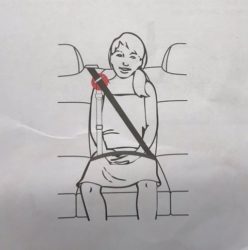The verbiage in a letter received by a customer and subsequently circulated online indicates that NHTSA has issued a cease-and-desist order to ClypX regarding its product claims and the company has begun notifying registered customers.
As described in SRN’s Sept/Oct 2018 issue, ClypX is a belt-positioning device consisting of an adjustable strap with a clip on one end that attaches to a lap belt and a clip on the other end that pulls the shoulder belt into position. Product packaging, labeling, and instructions all indicate compliance with FMVSS 213. While the product was called simply ClypX when the SRN article ran in 2018, the company has since also marketed it by the name Smart Kid Belt–Booster Seat, a name which further misleads consumers.
In 2018, NHTSA confirmed for CPST-I Jennifer Rubin (who had researched the product and contributed to the article) that the agency did not consider the product to be a CR and that, as an aftermarket product, it was not subject to FMVSS 213. Importantly, NHTSA stated that products that don’t fall under FMVSS 213 may not make claims to be compliant CRs.
The recent ClypX customer letter indicates that NHTSA followed up with the company on this censurable marketing. The letter started by giving the FMVSS 213 definition of a CR:
“Child restraint system means any device, except Type I or Type II seat belts, designed for use in a motor vehicle or aircraft to restrain, seat, or position children who weigh 36 kilograms (kg) (80 lb.) or less.”
Then the ClypX customer letter explained why NHTSA did not consider its product to be a booster.
“However, the National Highway Traffic Safety Administration (NHTSA) interpretations say that products like Smart Kid Belt that position the vehicle’s belt to fit the child seated in the seat do not position the child in the seat. Therefore, NHTSA states that the Smart Kid Belt does not meet the definition of a Child Restraint System as defined in FMVSS 213.”
As a result, ClypX stated that NHTSA required it to tell registered customers that the product is not a booster, saying:
“NHTSA has sent us a Cease and Desist Order requiring us to inform all previous purchasers of the Smart Kid Belt that the product is not a child restraint system or a booster seat as defined by FMVSS 213.”
The ClypX customer letter concluded saying:
“If are you [sic] dissatisfied with your SKB, please contact at: skb@clypx.com.”
While it is helpful to know NHTSA’s stance on this product (and others like it), this action did not result in banning the ClypX product from use. Therefore, owners, including those who didn’t register or get the letter, are still likely to use this product, which does not provide the protection of a booster and could, in fact, contribute to making a lap belt rise up onto a child’s abdomen. In addition to lacking adequate protectiveness, the product cannot be used to meet any state’s child occupant protection law, as it is neither a CR nor a booster.
SRN also notes that, despite NHTSA’s cease-and-desist order, the product can still be seen online using the disputed claims (including on Walmart.com at the time of this writing). However, on the company website, Clypx.com, a new product, comfiGO, has replaced the Smart Kid Belt. Despite having a flat seating surface, comfiGO, like Smart Kid Belt, appears not to meet the positioning requirements of a booster.
Find information on noncompliant CRs and how to report a problem here.

